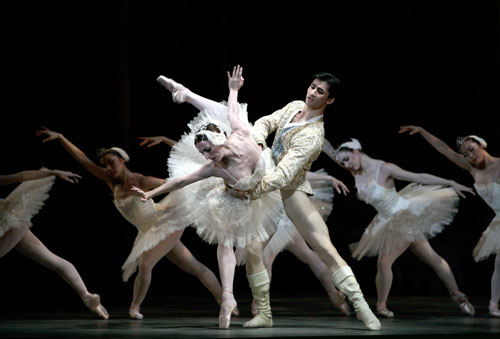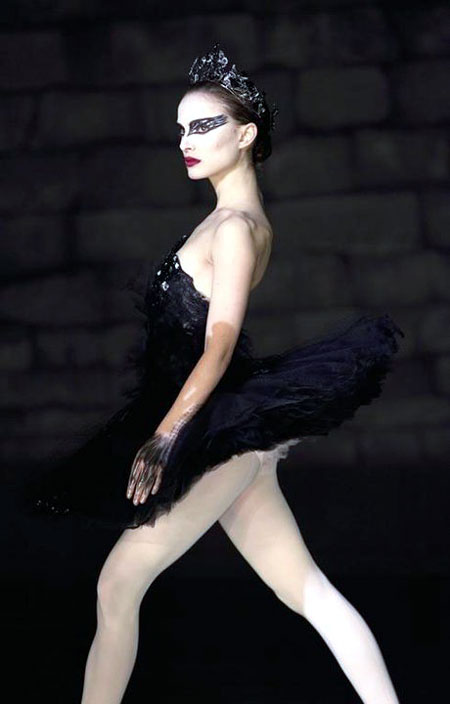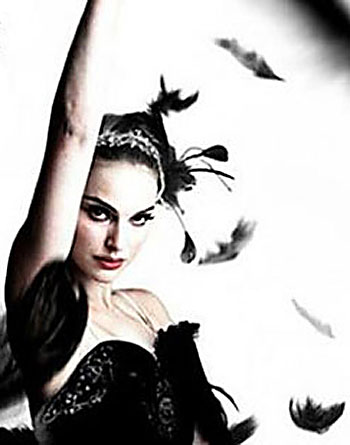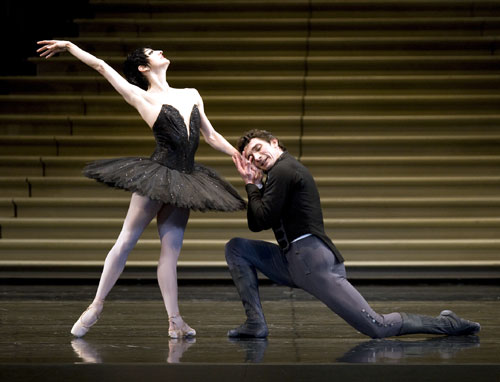|
Ballet dancers are not the most grounded people. They spend their lives surrounded by mirrors and other dancers, sequestered in studios, learning and repeating movement sequences over and over again. They devote their lives to creating roles, often fantastical or abstract, hoping to touch audiences with their ability to dissolve into ethereal images. Physically, all of their efforts are devoted to lifting their earthbound bodies into the air. Mentally, they are infantilized by all who surround them—their teachers and families collude to protect them from distraction—intellectual or other.
Like elite racehorses whose eyes are focused forward with protective blinders to prevent distraction, elite ballet dancers live in a protected world requiring enormous discipline and stamina. They are maintained in mirror-lined silos, their sustenance is music and desire. They desire perfection, they live to conquer gravity. Though there are exceptions, often emotional maturity, intellectual curiosity and social acuity are sacrificed at the altar of physical and emotional artifice. The minimum requirement of a at least a decade of intensive study, beginning as early as learning to read, requires so much physical energy that eventually even basic academic pursuit is truncated or postponed. After long days of practicing and rehearsing, they are so physically depleted they have little energy to pursue anything other than sedentary activities such as television, movies and possibly books.
Dancers are inspired by artistic ideals but are also motivated by competition. They must compete to get into the best school, to be named apprentice, and ultimately to be invited to join one of a small number of ballet dance companies around the world. Their lives are so insulated they tend to only make friends among other dancers but often these same dancers are also their competition. This singular combination of constant focus on the body, unrelenting striving and competition for perfection and better roles, and the need to turn their lives completely over to a dance company, is a problematic recipe.
Feelings of powerlessness fuel dancers to grasp control over the few areas in their life over which they enjoy sovereignty: what they eat, how they treat their bodies, and the material of their fantasy-lives. They, like all people, develop coping mechanisms and strategies for handling the ups and downs of their careers. However, the pressure is magnified by the predetermined brevity of their careers. Among the many stressful situations dancers face the process of doling out roles from the company's top-down hierarchy to the defenseless dancers is among the most treacherous. Of all roles in the classical canon, the lead in "Swan Lake" is arguably the most coveted.
 |
This role is not only physically beyond the reach of even most highly-trained dancers, it also requires acting skills that are not necessarily taught in a typical dancer's education. Being selected for this role would send any dancer into paroxysms of self-doubt. First, it is not actually one role but two. Odette, the white swan, is a swan by virtue of having been transformed by an evil sorcerer, forever trapped in the body of a bird unless a prince will promise absolute devotion to her. Her rival and opposite, Odile is the seductive and manipulative black swan who the sorcerer uses to distract the prince from his promised devotion to Odette. The role of Odette requires the famous bird-like gestures, quivering arms and legs, a portrait of innocence and fragility, a victim of male dominance. Odile is all flash and physical bravura. The life of the party, she carelessly seals Odette's fate by entrapping the prince.
"Black Swan," directed by Darren Aronofsky, employs the story of a ballet company in crisis as its artistic director plots to use a production of "Swan Lake" to save the company from obscurity. Natalie Portman portrays the central character, Nina, a young ballerina chosen, against the usual improbable odds of a performance-based movie, to play Odette/Odile. Petite and barely able to force language from her pouting mouth, Nina dresses in pink and white, sleeps in a bedroom cluttered with stuffed animals, a music box adorned with a ballerina, and her hovering mother (played by Barbara Hershey). The plot, such as it is, follows Nina through the process of preparing for her premiere performance. Between rehearsals Nina succumbs to self-destructive bouts of delusion, self-mutilation, kleptomania, bulimia, binge drinking and a little lesbian tryst thrown in for fun. And a whole lot of looking at herself in the mirror or any convenient mirror-like object.
Nina's character is surrounded by three other likewise over-the-top caricatures. Beth (Winona Ryder) is the aging former star whom Nina is replacing. Lily (Mila Kunis) is the wild and sexy newcomer to the company who may or may not be trying to sabotage Nina. Thomas (Vincent Cassel) is the nasty, self-absorbed choreographer who appears to be having way too much fun torturing Nina (that is, when not admiring himself in the mirror). After enduring the obligatory female competition scenes, the choreographer's alternating insults and attempts at seduction, his silent treatment of her repeated attempts to improve her interpretation of the role, and numerous graphic and elaborate scenes of Nina's self-destruction, we finally arrive at opening night.
 |
Apparently suffering from a schizophrenic breakdown does not prevent Nina from performing three hours of "Swan Lake." In between full costume and make-up changes she also finds time to smash a full-length mirror into bits and either murder Lily or stab herself in the belly. Fortunately, the aforementioned stabbing(s) neither inhibit her nor Lily's performances. At the end of the performances, after the obligatory wails of approval from the audience, poor Nina lies on her back on the stage mumbling about her triumphant perfection.
Credit for the overwrought screenplay goes to three different writers: Mark Heyman, Andrés Heinz, and John McLaughlin. The story is reportedly based upon another screenplay written by Heinz, entitled "The Understudy." Knowing this helped me understand why the movie is such a mess. At some point, I imagine, the director and original writer found themselves flailing without enough focus or insight to make a substantive movie about the interior life of a ballerina. So they chucked the whole thing into the lap of another writer. And then another. Then someone decided to layer special effects on top of the chaos in place of plot and character. Voilà ! A film that starts out being a somewhat realistic look into the physical and psychological life of a struggling young artist veers off into a silly melodramatic psychodrama.
The camera work adds to the horror. Though Ms. Portman claims to have trained as a dancer in her youth and to have worked very hard for a year to prepare for this role it was an absurd idea to try to pass her off as a ballerina capable of this most challenging of roles. Instead, by virtue of hand-held camera work, designed, in part, to distract us from the constant editing and computer-assisted magic used to hide her inability to dance, the eyes are unable to focus. The effect is laughable. In fact, the first time I saw the film I happened to be in the theatre with several groups of teenaged girls who howled with laughter. (A delightful relief from the pretentions of the filmmaker.)
 |
Ms. Portman is a lovely actress and a good one. She lost lots of weight and worked her muscles so that she could approximate, while standing absolutely still, some of the beauty and carriage of a real ballerina. Unfortunately, the rest cannot be faked, and try as she did, her ersatz arm movements and terribly short neck served only to constantly remind the audience that she is an imposter. The veil of illusion was never created so the layer upon layer of horror film tricks heaped into the film as it labored on became like too many gaudy ornaments weighing down a weak and sickly Christmas tree.
 |
I realize that the creators of this cinematic disaster were not making a documentary about the real life of a ballerina. I also realize that that story may not have found as wide an audience as the "psycho-sexual" melodrama created by Aronofsky and his collaborators. The success of "Black Swan" apparently justifies the creators' cynical gamble. They sacrificed a subtle coming-of-age story in favor of a blood and guts thriller about female cattiness and madness, murdering ambition, an isolated, smothering mother and a predatory choreographer. It might be laughable if it weren't such a sad reflection of the poverty of their collective imagination.
White Swan - Lorena Feijoo and David Karapetian
Black Swan - Lorena Feijoo and Pierre-François Vilanoba
Photos by Erik Tomasson
Courtesy of San Francisco Ballet
|

